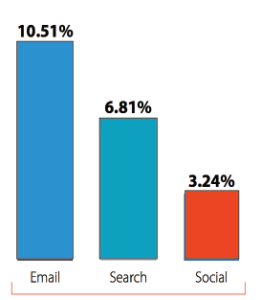Simply put, marketing is demand management. Your marketing generates and support sales, but it’s also an expense. If an extra dollar is spent on advertising that does not generate an extra dollar of gross margin, you shouldn’t be spending it. This is the essential yin and yang of the marketing budget.
Email generates the same amount of pageviews as other channels, such as search and social, but studies show it also has as much as FOUR TIMES the conversion rates of Social and 2x that of Search.


This begs the million dollar question, if email consistently has the highest conversion rate of all channels (search, social, etc.) then why does it consistently receive the least amount of budget?
“because email is so inexpensive, executives will pay less attention to it. This often results in less sophisticated associates being responsible for it. If something has a more significant budget assigned to it, then it will garner more attention and have higher level associates and larger teams dedicated to it because they’re needed to manage a more expensive property.” – Shar VanBoskirk
Essentially email gets a small budget because it doesn’t need a large budget to be effective. The mind of the executive thinks “Email? Check. We are doing that.” The right line of thinking should be: how do we get more from our email program?
Jay Baer of Convince & Convert spoke on the apathy of businesses towards their email saying,
“…because it’s by no means the new kid on the marketing block and hasn’t had many impactful technology jumps in recent years, I fear and see many companies are running their email programs on autopilot. This is a huge missed opportunity, because email is responsible for generating twice as much direct traffic as social media, and four times the conversion rate.”
Jay goes on to quote Forrester Research, stating that, “U.S. companies are spending more dollars on email, but the increase is marginal compared to the increased budgeting allocated to paid search and social.” Jay’s conclusion? “Maybe that’s misaligned, and companies should be paying more attention to email…”
So what are 6 key elements of effective email marketing that need to be added to your budget?
- Ensuring analytics are configured to analyze and optimize your campaigns.
- Creating data models of your best subscribers and then acquiring more of those in the right places.
- Syncing your e-commerce recommendations with your email programs to offer the same personalized experience in both channels.
- Starting, or increasing your use of triggered programs
- Educating yourself on the benefits of reveal based marketing and incorporating those strategies into your email mix, using both one off campaigns and out of the box toolsets like Scratch-it.
- Investing in coding and design talent to build beautiful bulletproof emails
The smart money is in email. Not to the exclusion of all other channels, but until their ROMI improves, the bottom line numbers make a strong case for email. If I were a digital marketer planning my 2015 budget, I’d put more money toward email. Even if it means re-allocating budget from another channel, both short and long-term payoff is in capitalized returns because email is a progressive investment. As you plan your budgets for 2015, ask yourself, “Why am I not investing even more in email?”
What a perfectly rectangular LinkedIn button. I bet you want to touch it. Go ahead! Touch the button.
